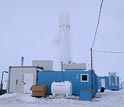|

Press Release 09-047
New Evidence From NSF-funded ANDRILL Demonstrates Climate Warming Affects Antarctic Ice Sheet Stability

March 18, 2009
For b-roll on Betacam SP of ANDRILL operating in Antarctica, contact Dena Headlee at (703) 292-7739 or dheadlee@nsf.gov.
See Other Recent IPY-related News A five-nation scientific team has published new evidence that even a slight rise in atmospheric concentrations of carbon dioxide, one of the gases that drives global warming, affects the stability of the West Antarctic Ice Sheet (WAIS). The massive WAIS covers the continent on the Pacific side of the Transantarctic Mountains. Any substantial melting of the ice sheet would cause a rise in global sea levels. The research, which was published in the March 19 issue of the journal Nature, is based on investigations by a 56-member team of scientists conducted on a 1,280-meter (4,100-foot)-long sedimentary rock core taken from beneath the sea floor under Antarctica's Ross Ice Shelf during the first project of the ANDRILL (ANtarctic geological DRILLing) research program--the McMurdo Ice Shelf (MIS) Project. The National Science Foundation (NSF), which manages the U.S. Antarctic Program (USAP), provided about $20 million in support of the ANDRILL program. The other ANDRILL national partners contributed an additional $10 million in science and logistics support. "The sedimentary record from the ANDRILL project provides scientists with an important analogue that can be used to help predict how ice shelves and the massive WAIS will respond to future global warming over the next few centuries," said Ross Powell, a professor of geology at Northern Illinois University. "The sedimentary record indicates that under global warming conditions that were similar to those projected to occur over the next century, protective ice shelves could shrink or even disappear and the WAIS would become vulnerable to melting," Powell said. "If the current warm period persists, the ice sheet could diminish substantially or even disappear over time. This would result in a potentially significant rise in sea levels." ANDRILL--which involves scientists from the United States, New Zealand, Italy and Germany--refines previous findings about the relationship between atmospheric carbon dioxide concentration, atmospheric and oceanic temperatures, sea level rise and natural cycles in Earth's orbit around the Sun, through the study of sediment and rock cores that are a geological archive of past climate. The dynamics of ice sheets, including WAIS, are not well understood, and improving scientists' comprehension of the mechanisms that control the growth, melting and movements of ice sheets was one of NSF's research priorities during the International Polar Year (IPY). The IPY field campaign, which officially ended March 2009, has been an intense scientific campaign to explore new frontiers in polar science, improve our understanding of the critical role of the polar regions in global processes, and educate students, teachers, and the public about the polar regions and their importance to the global system. NSF was the lead agency for U.S. IPY efforts. The cores retrieved by ANDRILL researchers have allowed them to peer back in time to the Pliocene era, roughly 2 million to 5 million years ago. During that era, the Antarctic was in a natural climate state that was warmer than today and atmospheric carbon dioxide levels were higher. Data from the cores indicate the WAIS advanced and retreated numerous times in response to forcing driven by these climate cycles. Powell and Tim Naish, director of Victoria University of Wellington's Antarctic Research Centre, served as co-chief scientists of the 2006-2007 ANDRILL project that retrieved the data and are lead authors in one of two companion studies published in Nature. Naish said the new information gleaned from the core shows that changes in the tilt of Earth's rotational axis has played a major role in ocean warming that has driven repeated cycles of growth and retreat of the WAIS for the period in Earth's history between 3 million and 5 million years ago. "It also appears that when atmospheric carbon dioxide concentrations reached 400 parts per million around four million years ago, the associated global warming amplified the effect of the Earth's axial tilt on the stability of the ice sheet," he said. "Carbon dioxide concentration in the atmosphere is again approaching 400 parts per million," Naish said. "Geological archives, such as the ANDRILL core, highlight the risk that a significant body of permanent Antarctic ice could be lost within the next century as Earth's climate continues to warm. Based on ANDRILL data combined with computer models of ice sheet behavior, collapse of the entire WAIS is likely to occur on the order of 1,000 years, but recent studies show that melting has already begun." The second ANDRILL study in Nature--led by David Pollard of Pennsylvania State University and Rob DeConto from University of Massachusetts--reports results from a computer model of the ice sheets. The model shows that each time the WAIS collapsed, some of the margins of the East Antarctic Ice Sheet also melted, and the combined effect was a global sea level rise of 7 meters above present-day levels. Whether the beginnings of such a collapse could start 100 years from now or within the next millennium is hard to predict and depends on future atmospheric CO2 levels, the researchers said. However, the new information from ANDRILL contributes a missing piece of the puzzle as scientists try to refine their predictions of the effects of global warming. The most recent report of the Intergovernmental Panel on Climate Change (IPCC) noted that because so little is understood about ice sheet behavior it is difficult to predict how ice sheets will contribute to sea level rise in a warming world. The behavior of ice sheets, the IPCC report said, is one of the major uncertainties in predicting exactly how the warming of the globe will affect human populations. "From these combined data modeling studies, we can say that past warming events caused West Antarctic ice shelves and ice grounded below sea level to melt and disappear. The modeling suggests these collapses took one to a few thousand years," Pollard said. Pollard and DeConto also underscored the role of ocean temperatures in melting of the ice. "It's clear from our combined research using geological data and modeling that ocean temperatures play a key role," DeConto said. "The most substantial melting of protective ice shelves comes from beneath the ice, where it is in contact with seawater. We now need more data to determine what is happening to the underside of contemporary ice shelves." The ANDRILL Science Management Office, located at the University of Nebraska-Lincoln, supports science planning and the activities of the international ANDRILL Science Committee (ASC). Antarctica New Zealand is the ANDRILL project operator and has developed the drilling system in collaboration with Alex Pyne at Victoria University of Wellington and Webster Drilling and Exploration. The U.S. Antarctic Program and Raytheon Polar Services Corporation (RPSC) supported the science team at McMurdo Station and in the Crary Science and Engineering Laboratory, while Antarctica New Zealand supported the drilling team at Scott Base. ANDRILL scientific studies are jointly supported by: the U.S. National Science Foundation, the New Zealand Foundation for Research, the Italian Antarctic Research Program, the German Science Foundation and the Alfred Wegener Institute. Recent IPY-related News: Return to top of release.
-NSF-

Media Contacts
Peter West, NSF (703) 292-7761 pwest@nsf.gov
Principal Investigators
David Pollard, Penn State University (814) 865-2022 pollard@essc.psu.edu
Ross Powell, Northern Illinois University (815) 753-7952, rpowell@niu.edu
Tim Naish, Victoria University of Wellington (NZ) 64 4 463 6197 Timothy.Naish@vuw.ac.nz
Related Websites
The ANDRILL Web site: http://www.andrill.org
The U.S. goverment's Web portal for the International Polar Year: http://www.ipy.gov

The National Science Foundation (NSF) is an independent federal agency that supports fundamental research and education across all fields of science and engineering. In fiscal year (FY) 2009, its budget is $9.5 billion, which includes $3.0 billion provided through the American Recovery and Reinvestment Act. NSF funds reach all 50 states through grants to over 1,900 universities and institutions. Each year, NSF receives about 44,400 competitive requests for funding, and makes over 11,500 new funding awards. NSF also awards over $400 million in professional and service contracts yearly.
 Get News Updates by Email Get News Updates by Email
Useful NSF Web Sites:
NSF Home Page: http://www.nsf.gov
NSF News: http://www.nsf.gov/news/
For the News Media: http://www.nsf.gov/news/newsroom.jsp
Science and Engineering Statistics: http://www.nsf.gov/statistics/
Awards Searches: http://www.nsf.gov/awardsearch/
| 




